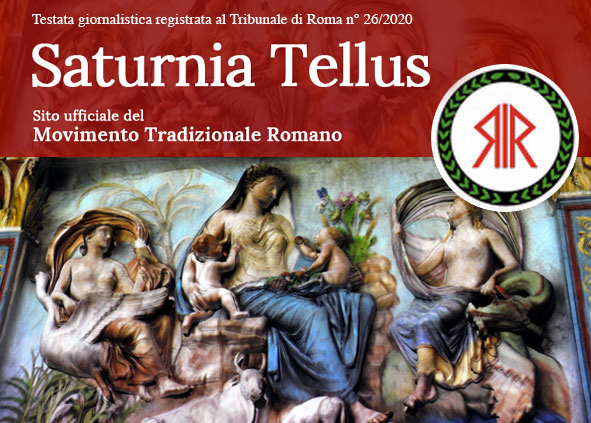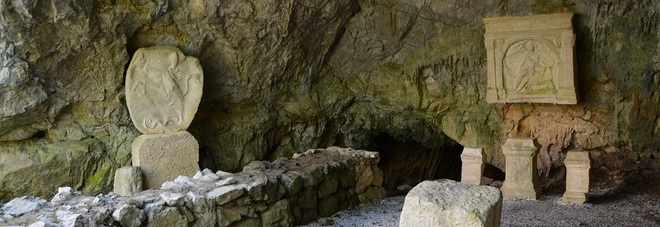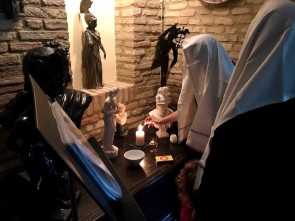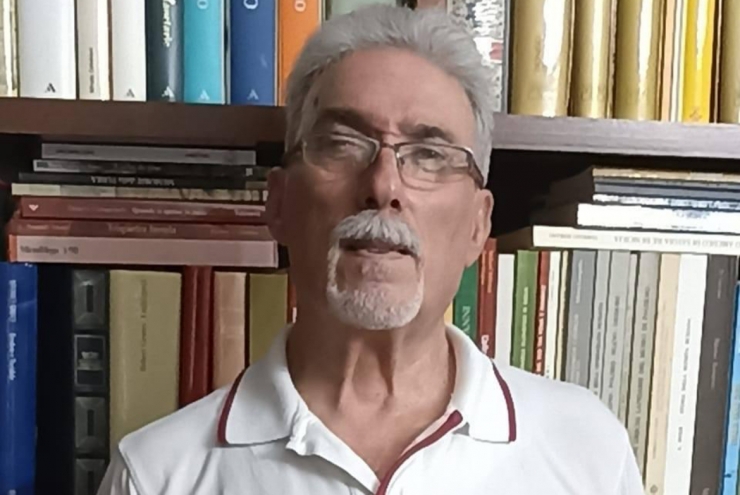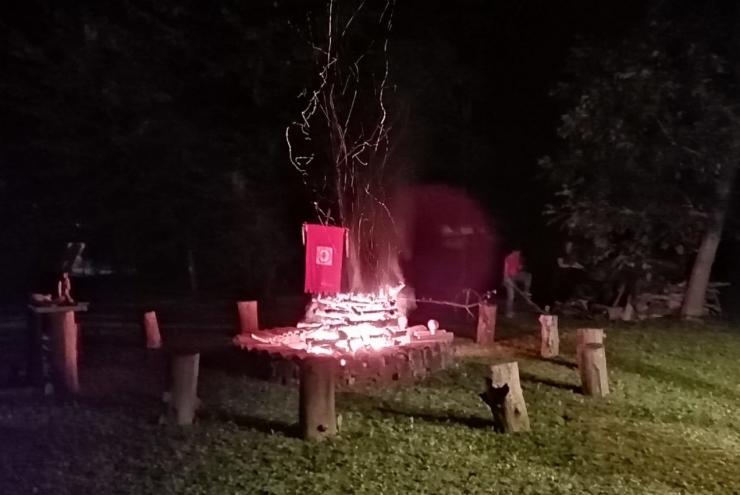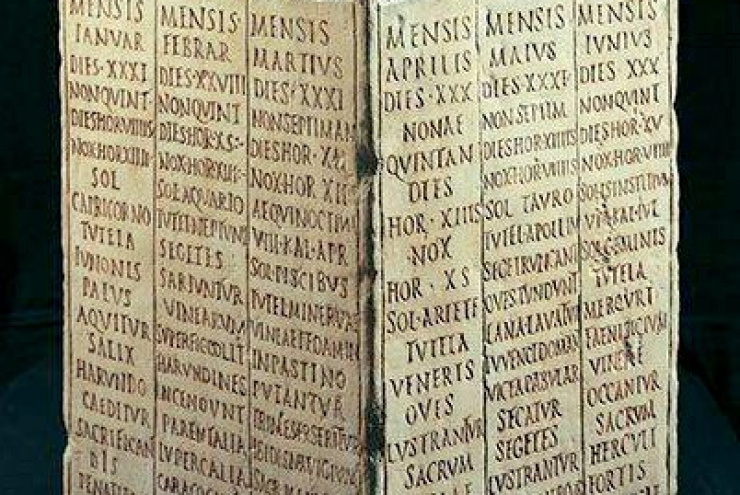The white linen dress on the skin. Scent of incense while the sacred flame burns on the lararium. Powerful invocation formulas on an ancient melody. Aware of the uniqueness of this precise moment and of its eternity, I feel the presence of the divine. A shiver runs through my back.
Those who have had the chance to participate in a good ritual may have perceived a sensation like the one just described and have not only sensed the sublime presence of the sacred and the transcendent, but also the providential favor of the deity invoked, or perhaps the deep fear aroused by awareness of the presence of the divine. Considering how such an experience of intense and unique mystical character is not effectively induced by any other form of social or intellectual activity, the essential importance in the modern polytheism of the ritual sphere is manifested: polytheism without rituals would be reduced to a cultural exercise or a nice social activity.
In other words, our reason for being a movement that aims to live the “Roman Religio” does not reside in the web page, in the articles more or less wise that we write, in large convivial events, in the photos we publish, or in our being an association or a fraternity. Our core is the ritual and its correct execution, that is the orthopraxy. From here it follows all the rest, like sweet fruits from an ancient generous tree of deep roots. Considering, therefore, the importance of the rite, this article aims to present a reflection not on a single ritual but on ritualism understood as a means of approach to the divine.
We do not know the sources that our ancestors used when they consolidated the tradition. We assume that they had the availability of texts that now have disappeared, or they had access to ancient oral traditions and could take advantage of a direct experience of the divine thanks to a favorable environment that facilitated access to augurs, sibyls, and haruspices, which in turn had a solid back millennial norm. Our ancestors then developed and consolidated a paradigm of myths, tales and rituals that we now understand as tradition, from the Latin “trādĕre”, which means “to deliver”.
As defenders of tradition, we like to follow the path marked by our ancestors, entrusting us to their expert understanding of the divine, and we wish to act as an intermediary for future generations, in the transmission of this ancient wisdom. Ritual is a fundamental part of the tradition, as it offers access to the direct experience of the divine, beyond any theoretical, philosophical or purely narrative formulation.
Although there are spontaneous religious forms not based on rituals and even if, considering the infinite power of the divine, no one can claim that theophany is limited only to the ritualistic sphere, however spontaneity, not being codifiable, is not transferable between generations through a tradition. Spontaneity is therefore not suitable for replacing ritualism, but it can be complementary: those who have a ritual knowledge can more easily grasp signs and intuitions in the context of spontaneous interaction with the divine.
A ritual, in addition to having the characteristic of being codifiable and transferable through the generations, induces a strong connection among those who perform it. The bond that is formed during the execution of a good rite can be very intense and lasting. Its power can also manifest itself from a distance when it is carried out simultaneously in different places. The ritual, therefore, besides being the fulcrum of tradition, has the function of strengthening and consolidating polytheistic associations and religious movements, which are not founded on a creed or social action, but on orthopraxy.
What has been written so far is an argument on the reasons why in the polytheistic movements that follow the ancient tradition, the ritual is a central and indispensable part. After treating the importance of ritual in tradition, as a fundamental means for the direct experience of the divine sphere, as a unifying force of a community and bond between generations, let us consider its justification in a more theoretical context, in relation to modern times.
Today ritualism can encounter many resistances in society, due to decades of deconstruction, of struggle against formalism, of exaltation of improvisation against any formal preparation. A process that was born as a revolt against what is called notionism but that has not been able to stop without falling into the opposite excess. It is the cultural catastrophe of modern times, reflected for example by many television programs, once carefully prepared and packaged, now strictly live, ugly, and forcefully true. Trash from “reality show”. This is not a tirade against improvisation which, when it means creativity, can be positive. Improvisation, with a solid knowledge of the subject, can be art. Jazz, for example, is not an easy musical style and so-called improvisation requires years of harmonic theory. Here we are talking about the lack of preparation, improvisation without study, the monster that has also infected politics, right and left, with politicians less and less prepared, more and more ignorant. It is a fact: modernity seems to reward unpreparedness and improvisation with respect to meticulous preparation and correct execution. In our case, modernity, mocking our rigor, seems to ask us: “Why repeat rituals like parrots instead of applying a modern spiritual spontaneity?”. We welcome the challenge, not so much to counter an imaginary controversy but to make things clear among us.
An argument that is not self-referential and based on the tautology of “we follow the tradition because we love the tradition”, can be based on two lines of thought developed in completely different times and environments, the first classical and philosophical, the second modern and psychological. After all, the greater the distance of the points of view, the more effective the binocular vision.
The polytheistic religion and its rituals began to attract the attention of the philosophers already in the context of the philosophical movement today identified as “Middle Platonism”. In the second century of the vulgar era the philosopher Numenius, recovering the second navigation of Plato and divinizing the Being, the Nous and the Universe, began to form a polytheistic theology (see the article “A Travel toward Neoplatonic Mysticism. Numenius from Apamea”)i. With Porphyry the attention moved towards magical practices and with Iamblichus a solid explanation was reached with a fundamental distinction between ritual magic, defined as white magic, and goetia or black magic. Ritual magic, opposed to goetia, aims at the elevation of the practitioner towards the Gods, through a long process of interior purification, through the exercise of virtues and through a careful and precise celebration of rites. Beyond the name “magic”, the purposes are not dissimilar from those of the private rite, where the officiant through ritual devotion seeks a greater affinity with the divine. According to Neoplatonism, there is a generative movement from the One to the Nous, from the Nous to the Psyche, from this to the material world, imbued with a participatory process that is religiously perceived as divine providence. Thanks to which, in the material world we can meet the symbols of the deities and use them in anagogical function, ie in order to ascend to the divine. In fact, in the last metaphysical passage in the chain of emanations, the Psyche copies eternal ideas from the Nous modeling them in the space-time of the material world. The process of participation of the material world in Psyche is called sympathy (συμπάθεια), in the sense of “affinity and participation” and is the basis of providence. Material things, therefore, thanks to their affinity, participate in the Psyche, ie they are modeled in a similar way to the ideas of the Nous. These, having still a certain degree of unity being interconnected with each other, give consistency to the things of the material world, which in this way are not purely chaotic but temporarily reflect a cosmic interconnection, a metaphysical order. In this understanding of reality, the function of the rite is to allow the ascent from the sphere of the perceptible world to spiritual and noumenic levels, towards the divinity.
The officiant, called “theurgist” by the Neoplatonic tradition, wish to impose the noumenal order on the material world. First of all, he defines the correct time frame (using the calendar) and spatial volume (temple), creating a bubble of order in the quasi-chaotic perceptible world. The concept of purity is nothing less than the elimination of the chaotic dross of instability of the perceptible world in the search for the noumenal order. Hence the aesthetic sense and the search for beauty and order during the ritual itself. The application of geometry is appropriate for the ritual, both in time and in space. The calendar ideally reflects the geometry of celestial mechanics. In the Roman calendar the months structured in kalends, nones, and ides, distributed during the year, are linked to the complex rhythm of the combination of the apparent motion of the sun and the moon. The temple, with its geometric shapes, ideally represents the order of space, with more or less complex symbols, depending on the wealth of the environment. The orientation of the temple represents the link with the motion of the stars and therefore the relationship between space and time.
During a ritual, the expert use of material objects in an orderly manner makes it possible to exploit the participation of the perceptible world at the higher levels to act directly on the psychic level (here not intended as psychological, but as Psyche). Moreover, the formulas uttered by the officiant are not just a sound but are a performative act, they are actions in all respects. In other words, speaking, a fact is immediately produced. The power of this kind of word was recognized since the ancient Egyptians as “heka”, the word which generates action, or magic. One can perceive this power of speech in the Latin ritual, where the synthetic nature of language amplifies the disruptive effect of the performative act. A simple statement like “ITA EST” has the strength and materiality of a seal on what has just been done. If the officiant exercises virtue in daily life and is already well disposed and relieved of unnecessary care, he has the possibility through the rite of rising to higher levels of consciousness, approaching his psyche to the cosmic nous and rediscovering the inner unity, that transcends the contradictions of perceptible existence, in a state of Pax Deorum Hominumque. This peace remains long after the ritual, allowing to look at the things of the world as they are: temporary and quasi-chaotic.
If the Neoplatonic metaphysics offers an excellent interpretative model on the efficacy of the ritual, another epistemological point of reflection is offered by an understanding of reality as explained by neuro-linguistic programming (NLP), which, although it has never obtained scientific recognition, offers a scheme of some behavioral processes based on the idea that there is a link between the behavioral patterns acquired with experience, language, and neurological connections. The idea has remarkable parallels with the gnoseological process of Stoic philosophy (see “A Travel toward Neoplatonic Mysticism: the Stoicism”)ii.
According to NLP, the first step in the perception of the world takes place through the five senses: we know that Stoicism states exactly the same in terms of “aisthesis”. In the moment in which we perceive something like an image, a sound, a smell, in our soul we generate a representation (stoicism: phantasia) that generates an immediate involuntary emotion (stoicism: synkatathesis). Our reaction to emotion makes us behave in a certain way, with which we interact with the surrounding environment, causing new events that will induce new perceptions, which will generate new emotions and so on. We human beings have the characteristic of filtering the stimuli (cancellation, distortion, generalization) to encode them in an experience. Based on experience we tend to generate behavioral sequences that later tend to repeat themselves. We get used to sequences of perceptions and we tend to react in the same way with sequences of behavior.
The conclusion of this brief discussion is that rituals are necessary and without them, nobody can really speak of “religio”. Personally, one of the most significant moments in my spiritual journey was a disarming simplicity and a transcendental power. My “Fratres” together with the “Pater” handed me the corpus of the rituals of MTR. It was the act of “tradition”, of transmission, an act in fact, not an opinion or a chat. A transition from hand to hand, from mind to mind, from heart to heart.
Strong of this great good luck, my thoughts turn to friends in Europe who follow traditions without certain sources on rituals. In the absence of reliable sources, I believe it is certainly better to establish rituals that are as close as possible to what could have been in the past, reconstructing celebrations, liturgies and even terms using ancient languages, rather than languishing in philosophizing and losing a unique opportunity to travel a path towards the divine. The generation and maintenance of a corpus is the bond of the community and the legacy that can be passed on to future generations, from hand to hand, from mind to mind, from heart to heart. For true work can begin only in front of the altar, through direct experience during a repeatable ritual, to recompose our soul and elevate it with a solid tradition to the eternal divine dimension.
Mario Basile
ihttps://www.saturniatellus.com/2017/09/travel-toward-neoplatonic-mysticism-philosophical-itinerary-viii-part/
iihttps://www.saturniatellus.com/2017/09/travel-toward-neoplatonic-mysticism-philosophical-itinerary-vii-part/

